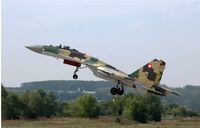Royal Radictistan Air Force
| Royal Radictistan Air Force | |
|---|---|
| Active | Present |
| Country | |
| Role | Air superiority, reconnaissance, close air support, air transport |
| Size | 174,000 personnel 2,300 aircraft |
| Part of | Ministry of Defense |
| Commanders | |
| Chief of the Air Staff | Colonel-General Sir Henry Baecker, KS |
| Deputy Chief of the Air Staff | Lieutenant-General Sir Thomas Walker, KS |
| Insignia | |
| Roundel |  |
| Ensign |  |
| Aircraft flown | |
| Attack | Su-25RM, L-159 |
| Bomber | Tu-22M, Tu-160, Su-32 |
| Fighter | MiG-35, Su-35, LY908 |
| Attack helicopter | Ka-52, Mi-24PN |
| Patrol | Tu-142 |
| Reconnaissance | Su-24, RQ-4, RQ-1, Sentinel R1, Tu-204R |
| Trainer | Yak-130, L-39, PC-7 MkII, T-1 |
| Transport | An-124, Il-76, An-72, An-32, Tu-204 |
The Royal Radictistan Air Force (Radictistani: Dukliche Radictistanische Luftwaffe) is the aerial warfare branch of the Radictistani armed forces. The service has a strength of about 168,000 personnel and over two thousand aircraft. The RRAF is a well-equipped force flying modern aircraft with highly-trained personnel. The air force is organized into several multi-wing commands each tasked with particular element of the aerial warfare mission. These are Air Combat Command, Air Mobility Command, Special Operations Command, Training Command, Support Command, Coastal Command, and Long Range Strike Command.
Structure
Commands
The Royal Radictistan Air Force is divided into seven Commands. Each Command is fully responsible for its component of the air warfare mission, except for Reserve Command which furnishes reservist personnel and their equipment to the other Commands. The seven Commands are:
- Air Combat Command: is responsible for the employment of tactical airpower in offensive and defensive operations. Trains, equips, and commands fighter, ground attack, reconnaissance, airborne early warning, CSAR, and surface-to-air missile units.
- Air Mobility Command: is responsible for tactical and strategic airlift as well as mid-air refueling of all RRAF tactical air assets. Trains, equips, and commands transport and tanker squadrons.
- Special Operations Command: is the special operations component of the RRAF. Contains the RRAF Regiment and provides air support for special operations units of all branches of the Radictistani military.
- Training Command: is responsible for recruit and pilot training.
- Support Command: maintains ground infrastructure. Also provides weather forecasting and fulfills other miscellaneous tasks.
- Coastal Command: is responsible for air operations over water against surface vessel and submarine threats.
- Long Range Strike Command: Trains, equips, supports and commands strategic bombing squadrons. Operates Tu-22M and Tu-160 strategic bombers as well as tanker aircraft.
- Reserve Command: Trains and equips all reserve formations of the RRAF. These units are transferred to the operational control of the other Commands when deployed on actual combat operations.
Squadrons
Multiple flying and nonflying squadrons are suboordinate to each Command. A flying squadron has six to twenty-four assigned aircraft with figher squadrons posessing the most, typically sixteen, twenty, or twenty-four. Nonflying squadrons include base maintenance and surface-to-air missile units. A squadron is typically commanded by a Lieutenant Colonel with a Major acting as Executive Officer.
Personnel
The Royal Radictistan Air Force numbers some 168,000 active and reserve personnel.
Flying hours
Pilots of fast jets achieve on average about 160 hours of flying time per year. Pilots in transport, bomber, and other units will typically accrue more hours. Flight time, particularly for fighter and bomber pilots, has declined as a result of economic pressures placed by the ongoing Norcustsur insurgency.
Officers
The majority of RRAF officers are trained at the Royal Air Force Academy and commissioned following completion of that three-year program. Others go through Officer Candidate School at either Brightburg Air Base in Erdwoodsur or Zweibul Air Base in Eastval. The OCS course lasts ten weeks. These establishments are a less common source of officers than their counterparts within the other branches of the Radictistani military. All commissioned officers except pilots have a six year active service commitment. Pilots incur a ten year commitment.
Warrant officers are selected from the enlisted ranks and trained at the Warrant Officer Candidate School located at Zweibul Air Base. Individuals can apply to attend WOCS with at least nine years of service and having obtained the rank of Senior Corporal or higher. The training program lasts for seven weeks.
Other ranks
Enlisted personnel are trained at Helding Air Base. As with the other branches of the Radictistani military, a large percentage of the junior enlisted personnel in the Air Force are conscripts. However this is a smaller proportion than is the case in the Army due to the advanced technical skills required of all personnel. Conscripts are inducted every June and serve for three years. After four years of service enlisted personnel can be promoted to the first noncommissioned officer rank of Senior Corporal (E-5).
Aircraft
The Royal Radictistan Air Force operates close to 900 combat aircraft in operational and training units, including fighters, strike aircraft, electronic warfare aircraft, maritime patrol aircraft, and strategic bombers. The Air Force also operates hundreds of noncombat aircraft such as transports.
Fighter and attack aircraft

The principal fighter aircraft of the RRAF is the Su-35BM multirole aircraft which is flown by eleven squadrons. The lighter MiG-35 and Lyran LY908 multirole fighter serve in smaller numbers. Some of the Lyran aircraft have been fitted with an indigenous IRST/TV system.
The Su-32 is operated in the medium range strike role. Close air support units are equipped with either the L-159 ALCA or the Su-25RM, a Radictistan-designed variant of the venerable Su-25.
Bombers
Long Range Strike Command operates two types of strategic bomber. 164 Squadron flies the Tu-160 bomber. 161 and 162 Squadrons fly the Tu-22M3.
Reconnaissance aircraft
While most reconnaissance functions of the Royal Radictistan Air Force can be fulfilled by combat aircraft carrying podded equipment, it also maintains two squadrons of Su-24MR aircraft. The Sentinel R.1 synthetic aperture radar aircraft is also utilized in the reconnaissance role. A specialized variant of the Tu-204 airliner is operated by 25 Squadron as a signals reconnaissance platform.
Electronic warfare
Two squadrons, one active and one reserve, operate the Lyran E-LY908A "Darkhawk" electronic jamming aircraft. A third squadron operates the Questerian Supermarine Sea Fury E.1 jamming aircraft.
Command and control aircraft
The RRAF operates 18 A-50U airborne early warning and control aircraft. The task of providing survivable command and control facilities for the Radictistani government falls to 169 Squadron which operates three Il-96VKP aircraft. These units possess highly capable communications facilities which allow the Grand Duke, Minister of Defense, and other top officials to maintain command and control links with all units of the Radictistani military in an emergency situation.
Airlift and tanker aircraft
Air Mobility Command operates An-124 and Il-76 aircraft in the strategic airlift role. The An-72 STOL jet and An-32 and A400M turboprops operate as theater transports. 4 Squadron operates three Boeing 757-200 aircraft in the VIP transport role, serving the Prime Minister, Cabinet, and Royal Family. 17 Squadron works the same role, but with smaller aircraft, the Boeing 737-700C and the CL 604 light jet. Several squadrons of Air Mobility Command operate the Il-78MK-90 tanker aircraft derived from the stock Il-76 transport. One squadron of Long Range Strike Command also operates the Il-78 to service Radictistan's small strategic bomber fleet.
Maritime patrol and strike aircraft
Coastal Command operates several types of aircraft in the maritime patrol and strike roles. Tu-142MZs serve as antisubmarine warfare and antisurface patrol platforms. 79 Squadron operates six Tu-142MRs as communications relays on behalf of the Royal Radictistan Navy's submarine force. The mission crew of these aircraft are seconded from the navy.
Coastal Command's 44 and 120 Squadrons operate the Tu-22M3 supersonic bomber in the maritime strike role. Their primary armament is the Kh-15S anti-shipping missile. Ten missiles can be carried onboard each aircraft. Radictistanti Tu-22Ms are also equipped with the Kh-32 missile. The Tu-22M3 fleet is undergoing an upgrade to the -M3M standard.
Training aircraft
Training Command is responsible for all training activities. For training aircrew, the command maintains several types of fixed-wing training aircraft. Ab initio training is conducted using the Konavia Mantis. Primary pilot training is conducted using the PC-7 MkII turboprop aircraft. Student pilots then advance to the L-39 and Yak-130 two-seater jets. Pilots assigned to fly multi-engine aircraft are trained on the T-1 Jayhawk. Fighter and bomber pilot trainees eventually go through advanced training with operational units. Non-pilot aircrew such as navigators and weapon systems officers train on the An-72Sau systems trainer.
Helicopters
The Royal Radictistan Air Force operates rotary wing aircraft in a variety of operational roles, including combat search and rescue, transport of special operations forces, and flight training.
Other missions
Two squadrons operate the An-32 in the weather reconnaissance role. RRAF An-72s and Il-76s can be fitted with modular fire retardant dispensers for use in fighting wildfires.
The testing of ballistic missiles by the Royal Radictistan Army is assisted by the Il-76RB aircraft of 76 Squadron which can accurately track the flight of missiles with onboard electro-optic systems. Detection of incoming ballistic missiles in a war scenario is provided by the three RAF-2 Weissbeck-K phased array radars operated by RRAF personnel of 207 (Radar) Squadron. The RRAF also operates the Grunsbeck over-the-horizon radar network. The RRAF operates the Common Airspace Control System in conjunction with the National Air Transit Authority.
The Royal Radictistan Air Force is also responsible for managing all of Radictistan's military space assets. These include communications satellites, reconnaissance satellites, and the GLONASS-R satellite navigation system. Available satellite data is analyzed both by Air Force units and by the Office of Military Intelligence.
212 and 213 Squadrons perform engineering support missions, particularly the rehabilitation of damaged airfields.
RRAF Regiment
The Royal Radictistan Air Force maintains an infantry unit, the RRAF Regiment, for the seizure of enemy-held airfields and the protection of RRAF installations in active theaters of war. The RRAF Regiment also has a secondary role of special reconnaissance. The regiment consists of five field squadrons, each the size of a standard infantry company, and two flying squadrons equipped with transport and attack helicopters. It is an all-volunteer unit along the lines of special operations forces maintained by the other branches of the Radictistani military.

